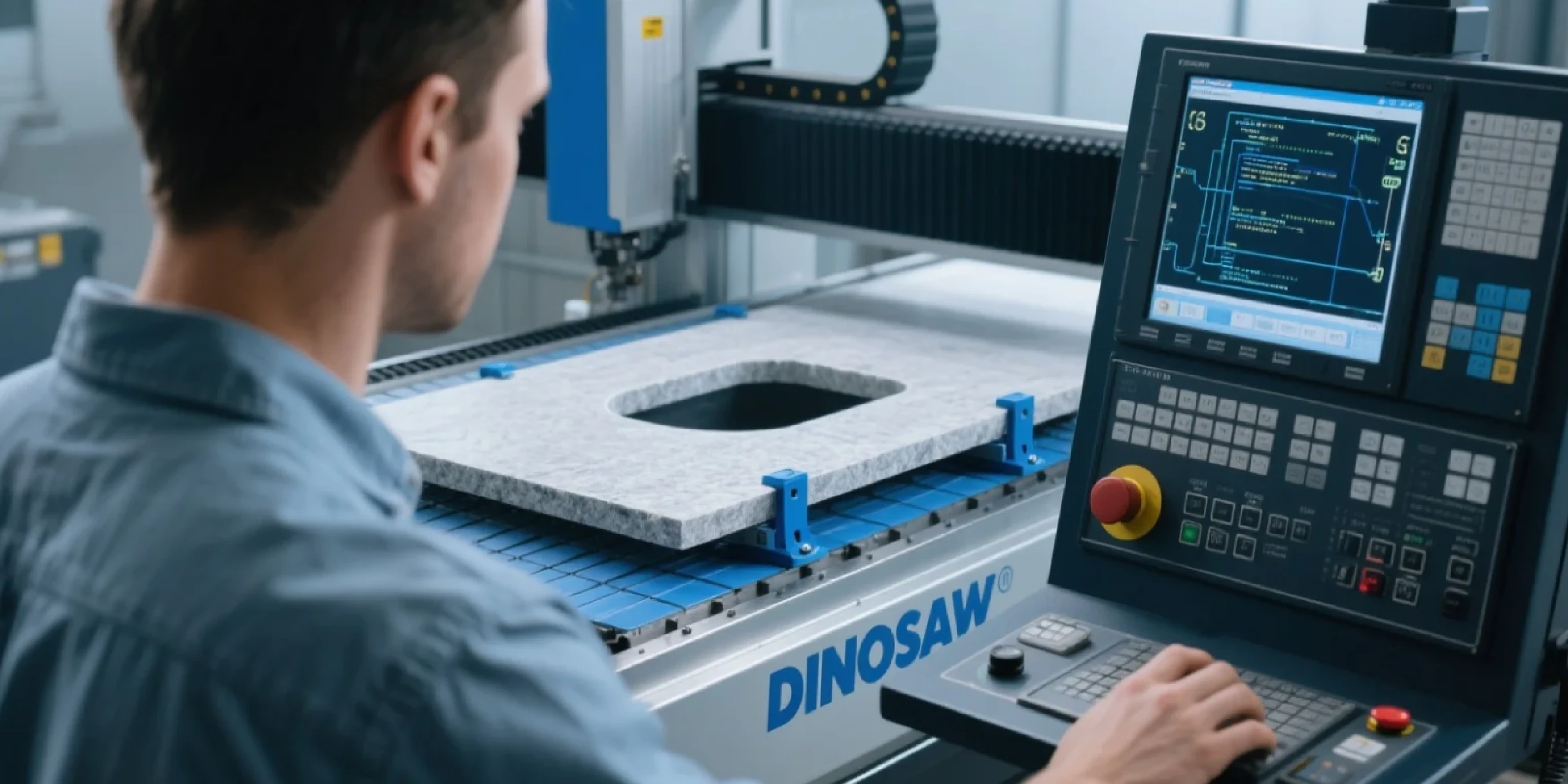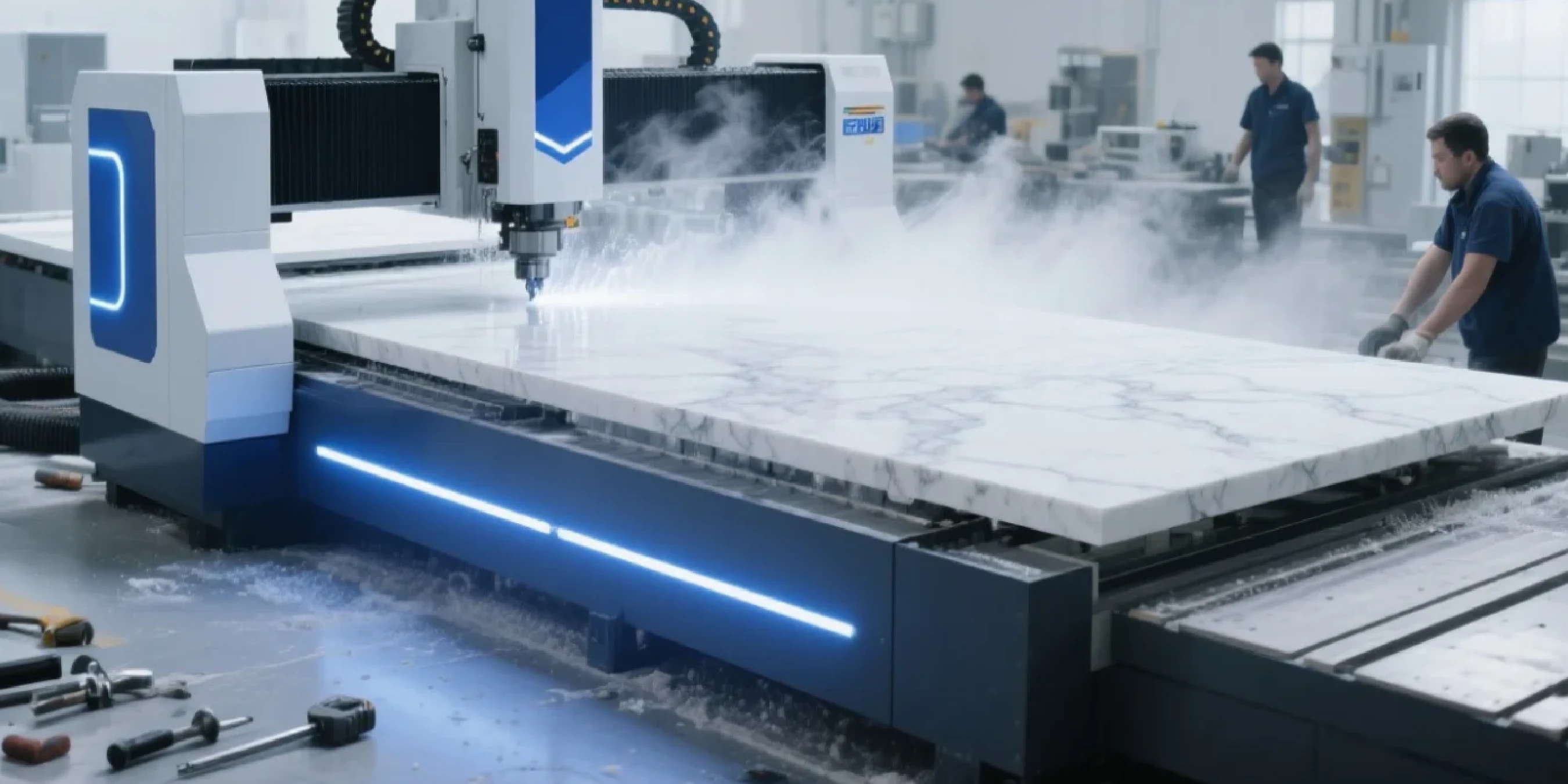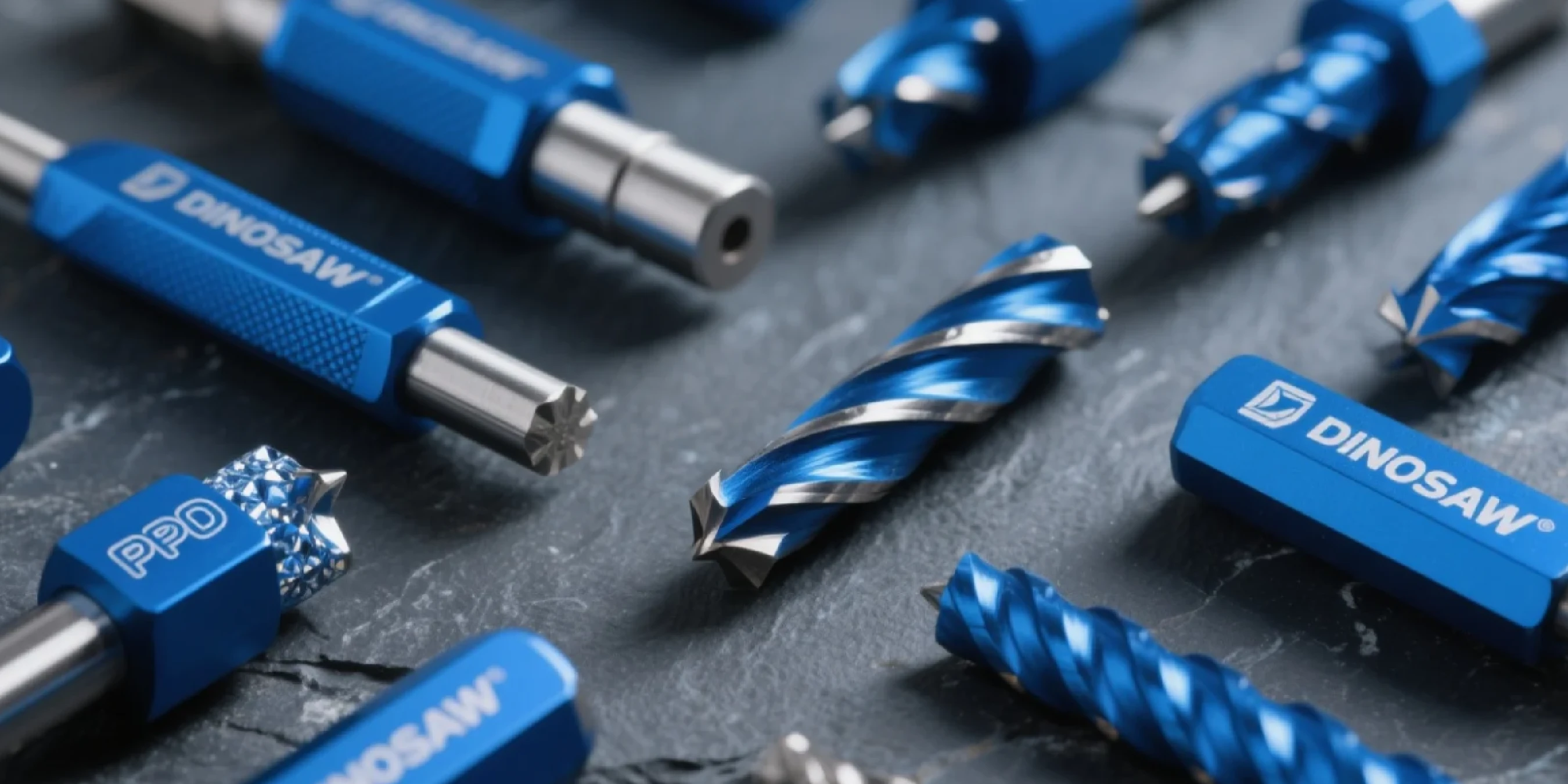Hi, this is Lizzy from Dinosaw ( Not a Robot ). Which Machine ( model ) do you want? Please WhatsApp us now
Unlock precision stone milling. Our expert guide covers machine setup, milling parameters for granite & quartz, tooling, and the entire CNC router workflow.
Here's the truth about stone milling: it's the difference between creating a $3,000 countertop and watching $500 worth of granite crumble into expensive gravel. Most workshops think they can tackle stone with their trusty wood router. That's like bringing a kitchen knife to a sword fight.
Stone milling isn't just about having sharp tools-though that matters. It's about understanding that granite, marble, and quartz each have their own "personality." Push too hard, and granite chips. Go too fast with marble, and you'll create heat that stuns the surface. Treat engineered quartz like natural stone? You'll melt the resin binder faster than you can say "expensive mistake."
This guide cuts through the technical jargon to give you what actually works. Whether you're a seasoned fabricator looking to eliminate those frustrating tool failures or a shop owner considering that first CNC investment, you'll walk away knowing exactly how to turn raw slabs into profitable, precision work.
Contact Dinosaw engineer for more support
Why Your Wood Router Will Destroy Expensive Stone
Let's address the elephant in the room: using a wood CNC for stone work. I've seen too many shops try this "cost-saving" approach, only to face catastrophic spindle failures, cracked frames, and ruined slabs. Here's why stone demands its own machine.
The Rigidity Factor: Why Mass Matters More Than You Think
Think of vibration as stone's enemy #1. Even microscopic chatter translates directly into chipped edges, premature tool failure, and-worst case-stress fractures that can destroy an entire slab. A proper stone router weighs 3-5 times more than its wood counterpart, with thick-walled steel construction that absorbs these destructive vibrations.
At Dinosaw, we engineer our frames using finite element analysis. Why? Because resonance frequencies that are harmless to wood can literally shake a diamond bit apart when cutting granite. This isn't marketing speak-it's physics.
Power vs. Speed: The Torque Revolution
Here's where most people get confused. Wood routers spin fast-sometimes 24,000 RPM. Stone routers? They focus on torque instead. You're not slicing through wood fibers; you're grinding through crystalline structures that would laugh at a high-speed wood bit.
A dedicated stone CNC features high-torque, water-cooled spindles. The water cooling serves double duty: it prevents spindle overheating during those marathon cutting sessions, and provides continuous coolant flow directly to the cutting zone. Without this setup, you're essentially dry-cutting stone-a guaranteed way to destroy both your tools and your material.
Reality Check: One customer saved $30,000 by buying a "modified" wood router for stone. Six months later, they spent $45,000 on a proper stone machine after destroying two spindles and countless diamond bits. The math is brutal but clear.

Know Your Stone: Material-Specific Milling Strategies
Not all stones are created equal. What works for marble will destroy quartz. What's perfect for granite might chip marble beyond repair. Let's break down each material's unique requirements.
Granite: Taming the Beast
Granite is nature's concrete-incredibly hard, somewhat brittle, and absolutely unforgiving to incorrect parameters. The latest USGS minerals report shows granite remains the dominant dimension stone in commercial applications, which means mastering its machining is essential for any serious fabricator.
Granite Milling Parameters
- Tool Choice: Sintered diamond bits only-electroplated won't last an hour
- Speed: 4,000-7,000 RPM (resist the urge to go faster)
- Feed Rate: 800-1500 mm/min (patience pays off)
- Coolant: High-flow water system-granite generates serious heat
The key insight? Granite responds better to grinding than cutting. Let those diamond crystals do their work gradually. Rush the process, and you'll either chip the edge or snap the bit.
Marble: The Deceptive Beauty
Marble looks easier to work with-and that's exactly the trap. Yes, it's softer than granite, but it's also more prone to "stunning" (subsurface damage) and creates incredibly fine, abrasive dust that can quickly clog your cutting area.
The secret with marble? Sharp, clean cuts with efficient debris removal. Electroplated or vacuum-brazed diamond bits often work better here because they maintain sharper cutting edges. But here's the catch: you can usually push the feed rate higher than granite, but you absolutely cannot let that abrasive slurry recirculate through your cutting zone.
Engineered Quartz: The Modern Challenge
Engineered quartz is everywhere now-and for good reason. It's consistent, non-porous, and gorgeous. But it's also a completely different animal from natural stone. You're dealing with quartz crystals bound in polymer resin, which means heat is your enemy.
PCD (Polycrystalline Diamond) tools are the gold standard here. They cost more upfront, but for high-volume quartz work, they're the only economical choice. The Natural Stone Institute emphasizes proper fabrication techniques as critical for maintaining both natural and engineered stone integrity.
Pro Tip: The Multi-Pass Strategy
Never try to cut through a full 3cm quartz slab in one pass. Use multiple shallow passes with a final "cleanup" pass at very light depth. This prevents heat buildup and eliminates the chipping that makes edges look amateur.

Your Complete Stone Milling Workflow
Successful stone milling starts long before the spindle turns. It's a systematic process where preparation matters as much as execution. Here's how the pros do it.
Step 1: Design and Toolpath Strategy
Your CAM software is where success or failure is determined. Programs like Vectric Aspire or Autodesk Fusion 360 let you define not just the cut path, but the strategy. Are you roughing material quickly, or making a precision finish pass? Each requires different parameters.
The output-your G-code file-contains every instruction the machine will follow. Get this wrong, and even the best equipment can't save you. For those wanting to dive deeper into the technical side, we have a complete guide on G-Code optimization for stone processing.
Step 2: Workholding That Won't Let You Down
A granite slab that shifts even a millimeter during cutting is ruined. Period. Most stone CNCs use vacuum pods, mechanical clamps, or custom jigs. The key? Distribute clamping forces evenly and always verify that the slab is perfectly level before starting.
Step 3: Setup and Tool Verification
This is where attention to detail separates pros from amateurs. You must establish your coordinate system (where X=0, Y=0, Z=0 on your workpiece) with precision. Install your cutting tool and verify its length offset in the machine controller. One mistake here ruins everything.
Step 4: The Critical First Minutes
Never walk away during the first few minutes of a new program. Listen to the cut. A smooth grinding sound is music to your ears. High-pitched squealing means your feed rate is too slow. Rough hammering or chattering? Stop immediately-something's wrong with your setup.
Ready to Upgrade Your Stone Fabrication?
Need expert advice on your specific project or want to find the perfect machine for your workshop? Our technical specialists are standing by.
Get Instant Expert Advice on WhatsApp →
Tool Selection: Your Arsenal for Stone Domination
Your machine is only as good as the bits you put in it. Diamond tooling isn't just recommended for stone-it's the only option that makes economic sense. But not all diamond tools are created equal.
Sintered Diamond: The Workhorse
These are your go-to tools for heavy material removal. Diamond particles are fused into a metal matrix, and as the matrix wears, fresh diamonds are exposed. Think of them as self-sharpening. They're perfect for sink cutouts, edge profiling, and aggressive roughing operations.
Electroplated Diamond: Precision and Detail
A single layer of diamonds bonded to the tool surface gives you incredibly sharp cutting action. These excel at detailed engraving, V-carving, and achieving fine finishes on softer stones like marble. The trade-off? They wear faster than sintered bits.
PCD Tools: The Investment-Grade Choice
Polycrystalline Diamond tools cost significantly more upfront, but for high-volume quartz fabrication, they're the only economically viable option. A quality PCD bit can outlast dozens of conventional diamond tools while maintaining consistent edge quality.
Speeds and Feeds: The Science Behind Perfect Cuts
Getting speeds and feeds right is part science, part art, and absolutely critical for both tool life and cut quality. The goal is creating a consistent chip load-the amount of material each cutting edge removes with every revolution.
Too aggressive? Your tool breaks or the material chips. Too conservative? You're just rubbing and creating heat, wearing out expensive diamond bits for no productive reason. Here's how to find that sweet spot.
Reading the Cut: What Your Machine Is Telling You
Experienced fabricators can diagnose problems just by listening. A smooth, consistent grinding sound means everything is working correctly. High-pitched squealing usually indicates too much speed and not enough feed rate-you're polishing instead of cutting.
Heavy rumbling or chattering? That's your machine telling you the feed rate is too aggressive for the current RPM. Back off the feed rate or increase spindle speed slightly. The material and your equipment will thank you.
Pro Insight: The Starting Point Strategy
Always start conservative with new materials or tools. Begin at 75% of recommended parameters, then gradually increase until you find the optimal balance between productivity and tool life. This approach has saved countless expensive bits and slabs.
Common Questions From Real Fabricators
What's a realistic budget for a professional stone CNC?
Plan on $40,000-$150,000 for a machine that can handle professional stone work reliably. I know that seems steep, but here's the reality: anything significantly cheaper will cost you more in the long run through maintenance, failed jobs, and replacement parts. Dinosaw machines are engineered specifically for the harsh environment of stone fabrication, focusing on durability and ROI rather than just low initial cost.
How long should I expect diamond bits to last?
Tool life varies dramatically based on material, parameters, and bit quality. A good sintered diamond bit on granite might give you 300-500 linear meters of cutting. PCD bits on quartz can last for thousands of meters. But here's what matters more: consistent results. A bit that starts chipping after 50 meters isn't saving you money, even if it was cheaper initially.
Is it safe to cut through a 3cm slab in one pass?
Absolutely not recommended for production work. While technically possible with the right setup, single-pass cutting through 3cm puts enormous stress on everything-your spindle, the bit, and the stone itself. Multiple passes (typically 3-4 for a 3cm slab) give you better edge quality, longer tool life, and much lower risk of catastrophic failure.
What's the most critical maintenance task?
Daily cleaning and lubrication, without question. Stone dust mixed with water creates an abrasive slurry that hardens like concrete on your machine's precision components. Fifteen minutes of proper cleanup at the end of each day prevents 90% of the mechanical problems we see in the field. Skip this, and you're looking at expensive repairs and downtime.
Do I need 5-axis capability for stone work?
Depends on your market. For standard countertops, sink cutouts, and basic edge profiles, a solid 3-axis machine handles 95% of the work. But if you want to offer premium services like waterfall edges, complex undermount sinks, or architectural details, 5-axis capability opens up possibilities that command premium pricing. For inspiration on advanced techniques, check out our complete guide to CNC stone carving.
Precision Pays & Transform Your Stone Fabrication Business
Mastering stone milling isn't about having the most expensive tools or the biggest machine. It's about understanding the fundamental relationship between material, machine, and technique. Respect the hardness of granite, work with marble's delicate nature, and manage heat when cutting quartz.
The shops that succeed long-term are those that invest in proper equipment from the start, develop systematic workflows, and never stop learning from their materials. Every stone slab has something to teach you-the question is whether you're listening.
Start with the fundamentals covered in this guide. Choose your equipment based on engineering rather than price. Develop consistent processes for setup, cutting, and maintenance. Most importantly, remember that in stone fabrication, there's no such thing as "good enough"-precision pays, and shortcuts always cost more in the end.
Ready to eliminate costly mistakes and unlock new revenue opportunities? Our CNC stone routers are engineered specifically for professional fabrication shops that demand reliability, precision, and profitability. Contact Us for Custom Solutions

























 English
English 中文
中文 Italian
Italian Türkçe
Türkçe Português
Português

